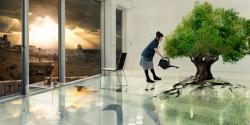
The English translation of this article was originally published by International Boulevard
From Al Safir Al Arabi
Behind the violence shaking occupied Jerusalem, writes Haneen Naamnih in Al Safir Al Arabi, is a vast colonial enterprise slowly remaking the city.
Jerusalem is (was?) an Arab city. But for Israeli nationalists, it is the capitol of their country, “eternal and undivided.” The process of remaking a “foreign” city into your own is first of all concrete: the inhabitants must be removed. But it is also symbolic; a link must be built to the imagined past when it was yours, and emblems of inconvenient reality expunged. More than just a Potemkin village to disguise the misery of Jerusalem’s native inhabitants, the vast construction projects Israel is carrying out in the occupied city are intended to remake the place as Israel’s trademarked claim to Palestine, Naamnih writes.
The illustrations here are stills from Larissa Sansour’s Nation Estate, a short film which imagines a dystopian future Palestine enclosed in a giant skyscraper-mall.
In 2013, Jerusalem hosted an exhibition show of Formula One car racing, transforming itself into a gigantic racetrack that attracted thousands of people eager to watch the thrilling event. The holy city with its ancient neighborhoods and native people suddenly became the background décor for throngs of the elite. For its guests, the city offered summery or wintery resorts and various recreational and cultural spectacles, produced locally or internationally. All in all, they could feel that they were visiting a very tranquil corner of European civilization.
Behind a complicated façade of modernization and urbanization, Israel has for two decades been hard at work reconstructing the image of Jerusalem in the global imagination, with the aim of transforming it into a cosmopolitan global city, attractive to local and foreign investment; remanufacturing it as an exotic tourist destination no less alluring than Paris, London or Berlin. Jerusalem as “World City”: an Israeli global commercial brand that generates endless profits on the colonization investment, the fact that it is under occupation a mere side note.
In this remaking, Israel narratively and symbolically erases the real Arab city from the mind, transforming it into an Orientalist ornament for its colonization project, a project that is simultaneously extracting the Arab city’s people and history from the city of Jerusalem. Havoc dressed up in the clothes of modernization.
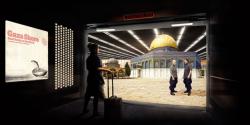
With its religious importance, bustling crowds of tourists are nothing new to Jerusalem. The city experienced a cultural renaissance in the late Ottoman period and throughout the years of British control, when it flourished through cultural, economic and scientific exchange with other important Arab cities. Even the Nakba of 1948 [creation of Israel], and the accompanying colonization of the new city [West Jerusalem] did not stop the flow of visitors. With an airport developed in the 1950s, the city could be described by the newspaper al-Manar al-Maqdissiya as “resembling a beehive.” Superstars like actor Omar Sharif and singers Fairouz and Mohamed Abdel Wahhab visited, as well as prominent international sports teams; the city was also a favored destination for school trips for children from Syria and Iraq.
But with defeat in the war of 1967, and the Israeli occupation of the Old City, Jerusalem’s beating heart, the city was knocked to its knees. The highway that had carried in all of those visitors from neighboring Arab countries was closed down, cutting the town off from its human environment. Jerusalem declined as a vibrant center of Arab culture, though its religious prestige remained untouched.
Like all other aspects of life in Jerusalem, tourism fell under Israeli control, as the occupiers took over most of the city’s museums and archaeological sites. Israel now took control of the tourist guides, who were forbidden from working unless they obtained a license from the Israeli ministry of Tourism, a process which meant pledging their allegiance to the Zionist narrative as a condition for working. As for the vendors of Oriental crafts in the Old City, once a pillar of the city’s tourist economy, their numbers steadily declined. Israeli vendors took over their customer base, since Israeli guides send their tour groups exclusively to Israeli merchants.
The two Intifadas had a profound impact on the tourism sector in the city. However, the decline of Palestinian participation in the tourism sector was primarily due to their inability to keep up with their Israeli counterparts. For example statistics show that nearly a million and a half tourists stayed in Jerusalem hotels in 2013, 88 percent in Israeli hotels and only 12 percent in Palestinian hotels. There are 5,817 hotel rooms in West Jerusalem and 1,969 in the East. 90 percent of hotel revenues go to those run by Israelis.
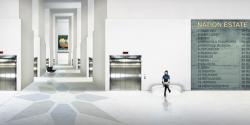
The absence of a Palestinian tourism infrastructure in a city of such importance is of course no coincidence. It is the result of the disappearance of any [Palestinian] governmental authority that can support it. What is left to maintain it are scarce sources of [Palestinian] wealth, and a few NGOs that rely on foreign financing; the Palestinian Ministry of Tourism has effectively ceased to exist here. And although the United Nations’ UNESCO has declared the city a World Heritage site, the international body is essentially powerless in this occupied city.
The Israeli takeover of Jerusalem’s airport was one of many ways that Palestinian sovereignty was stripped away; they no longer had any control over this or other points of entry and exit. The starvation and death of many revenue sectors followed as a consequence. The situation worsened as the city was cut off from the rest of Palestine in the aftermath of the Oslo agreements and the resulting Israeli policies against the Palestinians. The Israeli occupiers of the city borrowed from the global neoliberal system the techniques which they are applying here; the practice of repackaging great cities as a kind of consumer good, as the academic geographer David Harvey has described it. Tourism is obviously an essential consumer market for the ‘cities/goods,’ which typically manufacture whatever suits the well-being of visitors, even at the expense of the locals, or to the detriment of the city itself.
That is why if you visit Jerusalem today, wherever you look, you will see construction cranes, at the bottom of each of them signs and posters describing massive urban projects, luxurious condominiums, gigantic shopping malls, ‘national parks,’ museums, urban trains and modern bridges. All of this development now overseen by the private sector, with both local and foreign companies investing in large-scale projects intended to change the face of the city, as well as its underlying demographic and economic structure.
‘Jerusalem 5800’ [named for the Jewish calendar’s year 2040]is probably the pinnacle of these projects, a key to understanding the present wrecking of Jerusalem. Launched in 2011, the project is being financed by an Australian Jewish businessman [Kevin Bermeister], who previously invested in the construction of Jewish settlements in the heart of [Arab] East Jerusalem. The project gives a detailed vision of Jerusalem as it is meant to be in 2050, a global tourism destination that will attract 10 million foreign visitors and 2 million local visitors. It takes Rome as a model, striving to remake Jerusalem in the form of the Italian capital. To that end, there are plans to construct a new airport at a site near the Dead Sea to link the city to the rest of the world. And Jerusalem itself would be remanufactured as a huge metropolis comprising the [Palestinian West Bank] cities of Bethlehem, Ramallah, Jericho and the surrounding [Israeli] settlements as integral parts of the city.
The structural violence that underlies these vast urban projects is inherent to a fertile imperialist imagination that tries to cover reality with maps. Maps that erase the people, history, architecture and culture, all these inconvenient obstacles to constructing the new reality.
Their projects envision underground tunnels for trains that will run beneath the Old City; and they imagine enormous glass escalators as well; they want to transform all of the areas that surround old Jerusalem into hotels, and close the Old City down to traffic. The final death, in other words, of the Palestinian way of life and existence in their own city. And even as the [Jewish] residents of the city are being showered with good news of impending wealth and well-being, the city’s Palestinian residents are being crushed by poverty, ground down by a system that never pauses in its oppression.
For a week last June, every night as dusk fell on Jerusalem, projectors drew gigantic shapes and images on the walls and archaeological sites of the Old City. The Festival of Lights, organized by the municipality of Jerusalem in imitation of similar festivals in Milan, Amsterdam and elsewhere, was not welcomed by Palestinians since it annexed their share of the city’s public space, projecting onto it Jewish representations and symbols.
The festival and its figures of light are products of a wider logic, a vision of the city that not only contradicts its history, but also its lived reality; a vision that intends to remake the city into the image of a centrally (and eternally) cohesive centerpiece in the life of the Jews of the world, as described by Edward Said in his essay “Projecting Jerusalem”(1995).
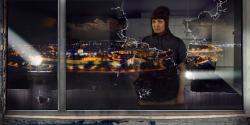
The author of Orientalism, himself born in the lost Jerusalem, was aware very early on of the role of imagination and movie-making in the process of remanufacturing Jerusalem as an Israeli city: first comes the new representation, and then the construction and the displacement follows. Starting with the Nakba, he reviews the incision that was sliced through the city in 1948, and how that dissection is now concealed within the occupied city.
Said writes tellingly of the meaning of a festival “Jerusalem 3000-City of David,” a 15 month long celebration of the conquest of the city by King David – 3,000 years ago. Since then, King David has become an ever more important and omnipresent symbol in the city’s religiously sacred precincts; the “Davidization” as researchers refer to it, of Jerusalem.
Hotels and luxury condominium developments are named after the biblical king; an imaginary “City of David” bible park was erected in the form of a giant tourist park in the obliterated neighborhood of Silwan. And Jerusalem’s [700-year-old] Mamluk citadel, located in the city’s western wall, has been transformed into the museum of the so-called “Tower of David,” one of its spires renamed the Tower of David, the citadel repurposed as a focal point for the numerous advertisements of urban projects and festivals, all as if to say that “we too have a tower like the Eiffel Tower.”
And even as these symbols of the city’s colonization are being produced, other symbols are being seized, the authentic ones that are legitimately rooted in the Arab and non-Arab imagination: most visibly the gilded Dome of the Rock, and the crowded souks of the Old City, still in constant motion in spite of the crushing garrote of Israeli occupation.
These symbols are repurposed as mere décor for the modernization projects, their treasured historical significance erased. The Dome of the Rock for example, was a major backdrop for one of the advertisements for the Formula 1 race, a symbol extracted from its true context.
Tourism here is more than a consumer market; it is also the ground on which a new narrative can be constructed, tell a new and exclusive story. Here, it is a very singular use of the cognitive power of colonialism. This perhaps explains why Israeli tourism organizations are so laser-focused on research, analysis, and opinion polling to come up with precisely the kinds of festivals and public entertainment that best fits the image of Jerusalem as an Israeli global city: modern technology to assemble a fabricated kind of culture that will nurture the abstract myths that Israel clings to like an infertile woman beseeching at the feet of the taleb [faith healer].
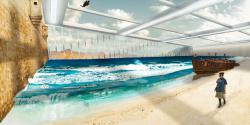
Some of the owners of the remaining Palestinian craft shops in the Old City sell souvenirs that carry symbols of Israeli identity: Jewish candlestick holders, or shirts that are imprinted in Hebrew, alongside souvenirs that bear the marks of the Palestinians. Though big cities everywhere are inherently places where opposites gather to either oppose or encounter one another, what is at stake in Jerusalem is something else: an enterprise of destruction, of both a way of being and an idea of the city. The colonization is confiscating the city from the Palestinians, it is undermining their ability to express a collective identity, to live in their city and protect the social and cultural heritage which were at the heart of their relationship to their own place. A place that once both gave and received from them. Today it is a place that does not even offer the possibility of making a real living to its people; now it chases them out, both concretely and symbolically, since it is impossible to dissociate the home demolitions and expulsions from the grand project of killing Jerusalem as an Arab urban space, and replacing it with another Jerusalem, an Israeli Jerusalem.
The dilemma of Jerusalem has always been rooted in the overwhelming symbolism it bears for all sides of the conflict. What the real city needs is a way to express a story that contradicts the one that the colonial power tells about it, one that expresses the life of the people in it, that dismantles all of the symbolisms and restores the human to the face of the occupied city. A story that will speak from every hole dug in its walls or from the tunnels beneath the ground, that will speak from a history that is simply impossible to truly confiscate in spite of all their efforts.


Leave a Reply